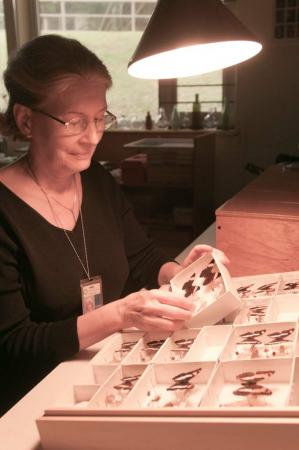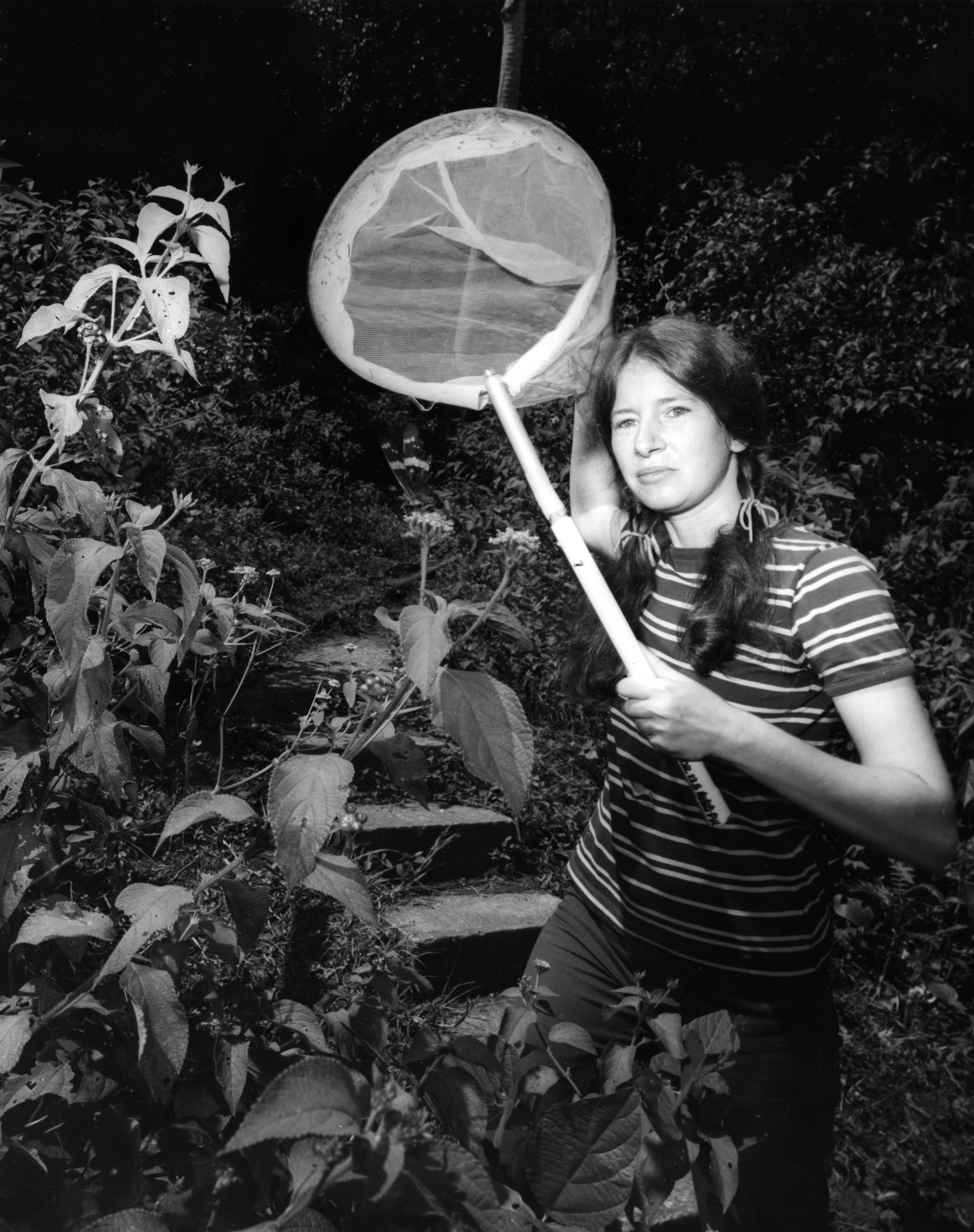Annette A. Aiello

Smithsonian Institution Archives Oral History Collection, SIA009624
When she was twenty-eight years old, Smithsonian Tropical Research Institute (STRI) staff scientist Annette Aiello (1941-) picked up a copy of Gray’s Manual of Botany to identify plants she photographed; that book changed her life. And the rest is history.
As a young girl, Aiello felt discouraged by educators, but when she discovered an interest in botany, she decided “it was time to go to college.” Aiello attended Brooklyn College, earning a B.S. in biology. She later received her M.A. and Ph.D. in biology from Harvard University. Aiello moved to Panama in 1978 and began her career as a research associate at STRI, where she found her passion for studying Lepidoptera (moths and butterflies). By 1991, Aiello was appointed a staff biologist.
Aiello’s oral history interview details her lifelong interest in the study of the natural world from rural Connecticut to Barro Colorado Island (BCI). The interview covers her education, early experiences on BCI, the discovery of her love for Lepidoptera, and her career as a STRI staff scientist in the 1990s. Aiello’s expertise and passion for her work with insects transcend the page as you read along.
“I loved nature. I had no idea you could study it.”
Session 1 00:12:31 – 00:13:54
HENSON: So, it must have been quite a transition to go from Brooklyn to really rural Connecticut.
AIELLO: Oh, I was lost. I took to the outdoors and I spent most of my time outside wandering around in the woods. The whole part of town that was abandoned, it was now forest and all the remains of that, old houses and dumps and all the interesting bottles and things in them, and this rock right in the middle of nowhere. I don’t know if I have a picture of it. Titus Coan was a missionary. He was born in Killingworth, [Connecticut], and he went to Patagonia, wrote Adventures in Patagonia, and eventually ended up in Hawaii, where he was a minister for many, many years, and he died there. But in the middle of the woods there is a big stone, big flat stone that’s engraved, and it says that this marks his birthplace, and it has all the information about where he died and so on. I loved nature. I had no idea you could study it. I had no guidance on that at all.
Gray’s Manual of Botany at Barnes and Noble
Session 1 00:17:15 – 00:19:01
AIELLO: So, I finished the photography school, and by that time it was spring and I had my first camera. I started taking pictures, color transparencies, and it was spring. I started taking pictures of all the wildflowers, went to Connecticut on weekends to see my parents, and I just took pictures like crazy. In the wintertime, I sat down and tried to identify them all. This is where god knows what makes someone do a thing like this.
I heard from someone about Gray’s Manual of Botany, and I went to Barnes and Noble and said I wanted that. They came up with this big thick book, has almost no pictures in it at all, and I bought it and I made Xerox copies of the glossary and the index—I still have the little notebook over there—so that I didn’t have to keep turning pages back. What I did was I looked up something that I knew, like dandelion, and found that page and read about it, looked in the glossary and tried to learn what the terms meant. I worked the keys backwards, because when you do a key to identification, you find where it is and now you go backwards and you see all the terms they’re applied to, and that’s what I did all winter long.
HENSON: But you’re learning botany.
AIELLO: I was learning. One day I said, “Wow, I think it’s time to go to college.” [LAUGHS] So, I went to Brooklyn College.
“Very curious about the caterpillars”
Session 1 00:26:16 – 00:27:45
AIELLO: I hadn’t quite finished that and I met [Robert E.] Bob Silberglied. Did you ever meet Bob?
HENSON: Yes. Yes.
AIELLO: We ended up coming here together. My little sister killed herself. She jumped in front of a subway train in Boston at Park Street Under, and I was totally devastated. She was twenty-one and I was thirty-four. She was the youngest. I’m the oldest of five.
I was spinning my wheels. Dr. Howard suggested that I go with Bob to Panama. He knew Bob was coming here for six months. Bob was on my committee, but eventually we became a couple. We worked on Anartia butterflies here and daddy long-legs, which I continued. We initially did that daddy long-legs project together, and then after a few weeks, he lost interest in it and I kept on. I still have to publish that stuff.
HENSON: But this is a major transition here, that you’re moving from plants to insects.
AIELLO: Yes. Being around Bob, what I knew about entomology I learned from him verbally, and at the lights, I learned the orders, really learned the orders at the lights on BCI [Barro Colorado Island]. I then got very curious about the caterpillars.
"We’ve been viewing butterflies wrong all this time.”
Session 1 00:40:14 – 00:41:31
AIELLO: I had these trays made with a mirror in the bottom with holes for the pin [photograph of four species of Adelpha pinned into the mirror tray]. When I was taking this picture for the talk, I found that you couldn’t get everything in focus using the conventional orientation with the bodies vertical, and I ended up turning the tray sideways. As soon as I did, then I could start to see some of the differences on the underside [the ventral side]. I think that we’ve been viewing butterflies the wrong way all this time. You need to look at them going across, not vertical, because you then don’t have to keep refocusing your eyes.
HENSON: Yes, the comparison, visually.
AIELLO: If you do a comparison this way [vertical], you’re refocusing all the time and you’re challenging your short-term memory. Here [horizontal], you just get a sweep. So, taking this picture taught me that. I thought that was so neat.
HENSON: Your background in photography is coming into play here, plus, as you said, you’ve got a background in art, which pattern analysis and visual acuity.
AIELLO: I’m one of these people who analyzes the ceiling tiles.
“Well, it’s not storage."
Session 1 01:26:21 – 01:29:08
AIELLO: We had started collecting insects on the island, had a small collection, but STRI was very anti-collections.
HENSON: I was going to ask you about this, because I know you have a collection.
AIELLO: Very, very anti-collection.
HENSON: This has been an issue since they started, to not have collections.
AIELLO: Those people, “those people,” them . . . .
HENSON: Set a bad precedent.
AIELLO: They are either dead or retired, most of them, that had any influence. And [Hindrik] Henk Wolda was unbelievable. He has a collection. We still have his collection. It’s very useful. But he was against collections. What did he think he had was? And he would say to me, “Well, once you rear these things, why don’t you just send that stuff to Washington?” How could I compare anything to anything? My stuff from ’77 through ’80 is up there, and it’s awful. I made a few trips up there in the nineties to get that collection in order and to put tray labels in, so that’s set now. I really feel better about that. I got a lot of identifications while I was there for that stuff.
So, you have to have collections, and it’s just occupying space. It’s storage. Well, it’s not storage. So that was quite something. Bob and I got a throwaway cabinet they were getting rid of at the museum, and they sent down. It was really a horrible thing, but it’s all we had.
HENSON: But it was a cabinet.
AIELLO: Each year, each of us would look for some particular group. We didn’t do Lepidoptera because they would have taken up too much room, but that’s what we really wanted to do. I did Homoptera, and he did katydids and so on. Some of them, we had some of the groups that we sent the specimens to Washington and got IDs for. In the collection, they are the ones with the little yellowish cardboard thing, typed with a big name typed on it, so people could see it without opening the drawer. We screwed them shut with Phillips screws.
But there was no one taking care of it out of there on BCI. When I got off the island, long after Bob was gone, I went out there and I just went with an empty drawer from here, which I had to fight to get these cabinets. When they built this building, I convinced them we needed to have an insect collection. They called it the dry collection, and the wet collection were the herps [amphibians and reptiles] in the jars. They didn’t even call it an insect collection. It was the dry collection. It’s only in the last few years that I got the name on the door changed to “insect collection.” It’s amazing, had the transformation, slow transformation.
Interested in other oral history interviews with staff from the Smithsonian Tropical Research Institute? Explore the finding aid.
- Smithsonian Tropical Research Institute History Interviews, 2010, 2013, Record Unit 9624, Smithsonian Institution Archives
For more about the Smithsonian Tropical Research Institute, head to their website
And to dive into Annette Aiello’s work, check out the sources below.
- Annette Aiello, bio, Smithsonian Tropical Research Institute
- Publications by Annette Aiello, Smithsonian Tropical Research Institute Bibliography
- Publications by Annette Aiello in PDF, Smithsonian Tropical Research Institute Bibliography
- Women In Science Wednesday: Dr. Annette Aiello, The Bigger Picture, Smithsonian Institution Archives




